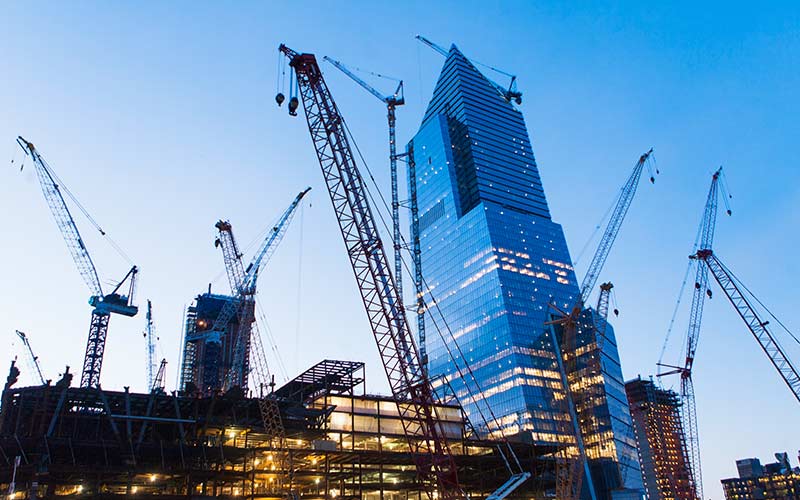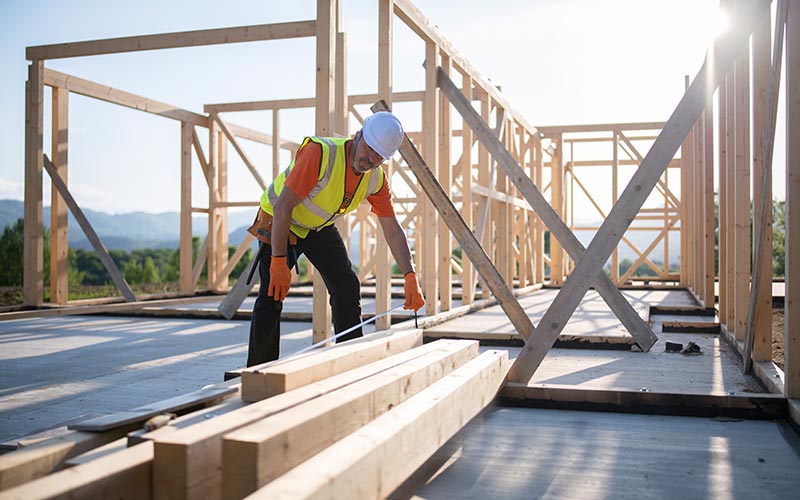
Insights
- The built environment is responsible for one-third of global greenhouse gas emissions, with embodied carbon from construction being a growing focus for reducing environmental impacts.
- Reducing operating carbon has been prioritized by many companies, but as energy grids decarbonize, embodied carbon — emitted during the construction phase — will become more critical.
- To effectively reduce both operational and embodied carbon, companies are turning to whole life carbon assessments, which measure emissions from the full life cycle of a building.
- Green retrofits and renovations perform even better, saving the owner or tenant an average of 11.5% in the first year and 17% over five years.
- While the upfront cost of green construction methods can be higher, the long-term savings from energy efficiency and regulatory compliance can offset these expenses, making sustainability economically viable.
- Green bond financing has grown in recent years and created a strong financial incentive to invest in WLCA and decarbonization projects. The green bond market reached $1 trillion in cumulative issuance between 2007 and 2020. In 2019, 28% of the total green bonds issued were used to finance green buildings.
Global business leaders have long promised to integrate environmental sustainability into their strategies and operations, with some companies making these commitments for decades. Often their actions fall short due to a misjudgment of the challenges and costs or lack of incentives. Regulatory patience is wearing thin, creating pressure to demonstrate progress.
Increased awareness of greenwashing, unclear decarbonization roadmaps, and slower than expected emissions reductions in recent years have heightened demands for accountability, often through more rigorous reporting. The EU’s Corporate Sustainability Reporting Directive (CSRD) now requires the region’s largest companies to adhere to stringent carbon reporting standards. In the US, new rules aim to “enhance and standardize” disclosure, although they are not as strict as those in the EU. California legislators have gone further with climate reporting laws that require Scope 3 emissions disclosure — a potentially significant impact since its economy is larger than all but four nations.
Regulatory pressure, combined with increasing demands from customers and value chain partners, is intensifying the call to reduce greenhouse gas (GHG) emissions as climate change warnings grow more dire. To limit global warming, organizers of the UN’s COP28 summit in 2023 concluded that GHG emissions must be reduced by 43% below 2019 levels by 2030. Consumer demand for sustainability is also likely to continue growing, particularly as more purchase power moves to the hands of more environmentally-focused millennial and Gen Z buyers.
Companies are already taking significant steps toward sustainability but cannot reach their goals without a comprehensive evaluation of their buildings. The built environment is responsible for more than one-third of global emissions and puts significant pressure on climate goals. The world is expected to construct new building space that is equivalent to the current building stock of New York City every month until 2060.
The increasing importance of embodied carbon
Companies are broadly aware of the carbon emissions associated with the energy consumption needed to operate their buildings. Widely available dashboards estimate emissions based on energy use and the local energy mix, or the mix of occupant or owner power purchase agreements. Reducing operating carbon has been the simplest way for companies to decrease their carbon footprints. However, this paints an incomplete picture of the decarbonization of buildings.
As energy grids decarbonize, other sources of carbon will become more significant factors in the built environment, and consequently for climate change. Embodied carbon emitted during the construction and demolition of buildings can potentially comprise up to 70% of a building's lifetime emissions. The World Green Building Council projects that between now and 2050, half the carbon emissions released by new buildings or infrastructure will occur before these facilities are occupied.
Unfortunately, measuring embodied carbon requires significantly more complex calculations, including the extraction, manufacturing, transportation, installation, maintenance, and disposal of building materials (Figure 1). Today, fewer embodied factors are measured compared to operational factors. However, organizations pursuing greater sustainability performance are turning to whole life carbon assessments (WLCA), a comprehensive evaluation that calculates and reports a building’s full carbon footprint.
Figure 1. Embodied carbon vs. operating carbon in the building life cycle
Source: C40 Knowledge Hub
These assessments calculate a building’s whole life carbon, the sum of all GHG emissions and removals associated with an asset throughout its life cycle. Beyond operations and construction emissions, these calculations include the carbon costs of disposing of building materials after their useful life, or the carbon savings when materials are reused. A WLCA is vital for making carbon-informed design decisions about new construction, retrofits, renovations, and tenant improvement projects. These assessments also aid compliance reporting with regulations after project completion.
The concept of reducing whole life carbon is simple: First, measure the whole life carbon to set a baseline; then utilize design principles with low-carbon materials and sustainable construction practices; and finally, report on the improvements. With data measurements from a WLCA, owners can reduce embodied carbon by up to 50% in the building’s outer envelope, 45% in the building structure, and 35% in the building systems through passive designs or recycled system assets, according to Carbon Risk Real Estate Monitor. The decisions and execution that follow, however, are far from simple.
WLCA: Measuring cradle to grave
WLCA guide companies in the right direction to decarbonize, but assumptions, calculations, and conclusions may vary. Successful implementation requires a well-designed WLCA framework to manage the increased complexity of calculating emissions and to minimize the difficulty of understanding costs and where to start. A standardized WLCA framework offers maximum value by reducing inconsistencies across industries and regions and allowing enterprises to benchmark low-carbon designs against traditional ones.
Infosys is collaborating with government and industry leaders to promote a new set of incentives, policies, and standards based on the Royal Institution of Chartered Surveyors (RICS) WLCA standard, currently the most comprehensive methodology to assess buildings and infrastructure. The RICS standard aligns with cost management frameworks, such as the International Cost Management Standard 3 and RICS New Rules of Measurement, which help organizations assess and reduce carbon and costs.
Although demand for sustainable construction is growing, three primary factors constrain progress. The World Green Building Council identified the most significant barriers to sustainable construction as cost, political support and incentives, and public awareness. Each of these barriers can be reduced through the adoption of WLCA standards and the clarity gained from standardized carbon assessments.
Cost: Building green and the bottom line
As with any sustainability initiative, cost is the first and often the most important challenge. How much more does it cost compared to traditional methods? How do you measure short- and long-term benefits?
Cost criteria carry nonlinear risk in building design and construction, or retrofitting, as standard building methods can quickly spiral into millions or even billions of dollars for sprawling campuses or high-tech factories. Even small changes to design and materials can lead to significant cost overruns.
In addition, a lack of shared data throughout the supply chain adds complexity in tracking a building’s carbon footprint across its lifespan. While WLCA provides data on carbon savings, uncertainty over return on investment (ROI) causes many developers to hesitate, even those aggressively seeking net-zero emissions.

Cost savings and rental premiums
Evidence is mounting in favor of the economics of green buildings. Research from the nonprofit RMI found that companies can reduce embodied carbon by 19% to 46% during the design and construction phase while incurring a cost premium of 1% or less. The greatest carbon reduction impacts come from greener concrete, rebar, insulation, and glazing. Further reductions are possible through a whole-building design approach, where energy saving assets offset operational costs and emissions.
WLCA highlight areas for design optimization and lead to more energy-efficient buildings, reducing operational costs by 10.5% over one year and 16.9% over five years. Green retrofits and renovations perform even better, saving the owner or tenant an average of 11.5% in the first year and 17% over five years, according to Dodge Data & Analytics’ World Green Building Trends 2021. Moreover, low embodied carbon construction such as modular buildings has been shown to reduce construction costs by accelerating project timelines by 20% to 50%.
Infosys applied a smart spaces approach to its massive campuses (50 million square feet) in India, resulting in slowed growth of electricity usage and substantial savings. Between 2008 and 2015, electricity usage at Infosys campuses increased by only 13% despite a 120% increase in the number of employees. This avoided 900 million kilowatt hours of electricity use, 750,000 tons of CO2, and $100 million in electricity bills. This was instrumental in the company achieving carbon neutrality in 2020, a full 30 years ahead of the Paris Agreement goals.
Greater energy efficiency delivers not only direct cost savings but also an opportunity to increase a building’s asset value and ability to charge higher rents. The UK Green Building Council found that higher upfront costs to assess and construct sustainable buildings are often lower than expected and can be offset or even recouped through rental value increases of 6% to 11%, combined with higher average occupancy rates (4.1%) for LEED buildings. Additionally, the organization’s report asserts that the rental premium and yield compression may improve the average profit-over-cost ratio from 15% to 20%.
However, these benefits can also lead to a halo effect in which the value of nearby, nongreen buildings benefit from the rising values and occupancies of its sustainable neighbors.

Calculating the benefits
Research suggests that green buildings offer positive financial returns over time, though initial construction costs pose significant challenges to developers. Business leaders need proven tools, technology, and processes to calculate the ROI of WLCA and decarbonization projects.
The RICS WLCA standard aligns with cost management frameworks such as the International Cost Management Standard (ICMS) 3 and RICS New Rules of Measurement. These standards help organizations assess and reduce both carbon and costs. By integrating carbon data into cost management processes, ICMS 3 enables developers to make more informed decisions about materials, technologies, and building systems — optimizing costs while minimizing environmental impact.
A building information model (BIM) can also be an effective tool to integrate cost assessments with WLCA. A BIM quantifies the materials and construction activities used, then multiplies the total against carbon-intensity factors to arrive at carbon emissions data. The RICS Professional Standard on WLCA has found that BIM integration improves WLCA accessibility, accuracy, and ease by reducing calculation effort and labor expenses, minimizing design errors, and facilitating collaboration among developers and facility management.
Political support and incentives: A foundation for sustainability
Most of the world’s governments are incentivizing their citizens and the private sector to move toward a low-carbon economy, but measures are inconsistent from country to country and even within nations. This inconsistency prevents carbon data about industrial products from flowing easily into the design and construction phases or to asset owners for facility maintenance. When materials are purchased or construction processes occur internationally, centralized carbon reporting breaks down due to unreliable estimates of emissions from other nations or states. Currently, there are no international carbon emissions reporting platforms to provide benchmarks and carbon factor libraries. The lack of comprehensive regulation, policy, and incentives has produced inconsistent outcomes in carbon tracking and reduction efforts in the building sector.
However, a growing movement for coordinated international policy on WLCA, as well as more local incentives and regulations, is enabling the adoption of low-carbon designs. Developers will need to adapt to stricter carbon accounting regulations to stay competitive. Early adoption may save them money in the long run by avoiding noncompliance fees, carbon taxes, and by taking advantage of green bond financing.

Reporting requirements
New government requirements are pressuring companies to standardize their carbon reporting. The European Sustainability Reporting Standards and the US Securities and Exchange Commission’s Climate Related Disclosures for Investors are two of the most prominent regulations affecting large multinational companies. The regulatory environment has created a strong business case for adoption, as noncompliance could be met with significant fines and public censure. Standardized WLCA policy will help affected companies report the emissions into these regulatory frameworks more effectively and across borders.
WLCA policy standardization progressed substantially in 2023, driven by a global taskforce of policy and construction experts, in coordination with the G20 Global Smart Cities Alliance on Technology Governance, the World Economic Forum (WEF), and C40 Cities. The policies were guided by regulations already in place in Toronto, Amsterdam, and London. In November 2023, the WEF task force (with several members from Infosys) published three documents: a model policy to help cities draft legislation mandating WLCA for major developments, a playbook for adopting this policy, and guidance for the private sector’s efforts to adapt to these policy changes.
Limiting carbon through pricing and lending
Carbon pricing and restrictions are increasingly popular policy tools, often working in tandem. Canada plans to increase its carbon tax by 450% between 2020 and 2030, penalizing high-carbon projects, according to the World Green Building Council. Some countries are also mandating WLCA to increase transparency and, in some cases, limit carbon footprints, according to C40 Cities. For the last decade, the Netherlands has required WLCA and whole life carbon limits for new residential or office buildings larger than 100 square meters.
Many of these carbon tax and restriction efforts have delivered significant reductions. Carbon pricing was responsible for at least one-third of emissions reductions in Sweden between 1991 and 2015, according to researchers from the Swedish House of Finance. If not for carbon pricing, emissions would have been 30% higher there. The World Bank has reported that the 75 carbon pricing instruments now available — covering nearly one-quarter of the world’s emissions — raised $104 billion in 2023. Most proceeds benefit programs that support nature and the climate.
Green bond financing has grown in recent years and created a strong financial incentive to invest in WLCA and decarbonization projects. The green bond market reached $1 trillion in cumulative issuance between 2007 and 2020. In 2019, 28% of the total green bonds issued were used to finance green buildings, according to Environmental Finance. Green bonds attract investors seeking sustainable investment options, which could lower interest rates and borrowing costs for green building projects.

Public awareness: Pressure and competitive advantage
The race to create a more sustainable world has focused primarily on transportation and energy generation. However, regulatory changes in Europe and North America are driving action in those regions, along with growing consumer demand for sustainable buildings. In other parts of the world, such as sub-Saharan Africa, public awareness lags but is growing.
The public understanding of sustainable buildings, however, has been oversimplified. The environmental impact of buildings has often been reduced to energy consumption and its sources (renewable vs. fossil fuels). While operational energy efficiency has traditionally taken precedence, the significance of embodied carbon — spanning extensive value chains — presents a more intricate challenge. As interest in green buildings grows, industry groups and nongovernmental organizations are educating building owners, tenants, and managers about the significance of whole life carbon and how it can keep businesses on a sustainable path.
The benefits of leading by example
Most large companies present themselves as sustainable organizations that are serious about reducing GHG emissions and slowing environmental degradation. The business benefits of sustainability are well established, and the commitment to green building investment is growing quickly. The Dodge Data & Analytics World Green Building Trends report cited a 14% growth in the share of building sector respondents who intend to make at least 60% of their projects green.
Reputational gains are a strong incentive to invest in WLCA and decarbonization. Seventy-seven percent of consumers and 73% of investors prefer companies that are committed to environmental responsibility, according to a survey from US insurance company AFLAC. However, the EU has found that 53% of green claims provide customers with “vague, misleading or unfounded information.”
As more companies embrace sustainability principles and package them in slick communications, it becomes increasingly difficult for businesses to distinguish themselves from their competitors. Often, the rhetoric does not live up to the reality. This greenwashing can harm a company’s reputation and profits.
Data and transparency are the ultimate defense against claims of greenwashing. Organizations can bolster their brand reputation by using standardized WLCA to demonstrate commitment to decarbonizing their real estate portfolios and align with corporate reporting standards. Measuring embodied and operational carbon data — covering Scope 1, 2, and 3 emissions. For now, the SEC mandates only the reporting of Scope 1 and 2 emissions, but California disclosure regulations and the EU’s Corporate Sustainability Reporting Directive require companies to report Scope 3 emissions, such as purchased goods and services, upstream and downstream logistics, and waste disposal. A comprehensive WLCA covers all these emissions factors and conforms to the highest reporting requirements.

A sustainable future is within reach
International collaboration on sustainability initiatives is increasing through both policy frameworks and voluntary actions. National governments and private organizations need to harmonize data across different regions. Cities and countries will benefit from gradually mandating WLCA for all buildings, starting with public and large-scale projects. At the same time, regulations can set science-based national targets for building decarbonization, supported by updated building codes, incentives, and procurement policies.
To keep up with changing policies, companies do not need to start from scratch. A growing number of resources, such as the Practitioners’ Guide to Whole Life Carbon Assessments, offers advice on setting assessment objectives, defining scope, accessing information on environmental product declarations, and developing benchmarks and decarbonization targets.
Integrating WLCA into design and planning enables informed decision-making, including the selection of low carbon materials and construction methods. Standardized WLCA policies help governments monitor progress, while the private sector gains sharable data and tools for supply chain coordination and project benchmarking. WLCA provides a framework for builders to demonstrate their commitment to sustainability while attracting favorable financing and incentives and sharpening their competitive edge.






